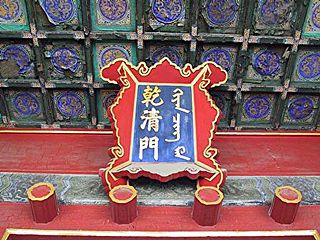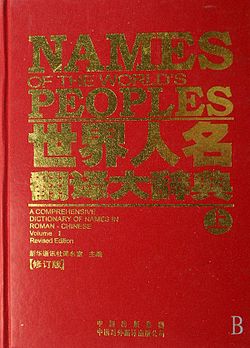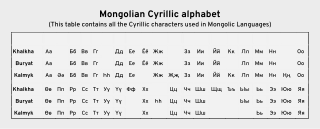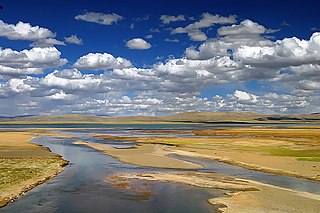
ᠳ᠋ᠸ
ᠵᠢᠢkwn dw jii for Standard Chinese 肯德基 kěn dé jī ("Kentucky").
| Romanization of Chinese |
|---|
| Mandarin |
| Wu |
| Yue |
| Min |
| Gan |
| Hakka |
| Xiang |
| Polylectal |
| See also |
Mongolian transliteration of Chinese characters is a system of transliterating the Standard Chinese pinyin readings of Chinese characters using the traditional Mongolian script that is used in Inner Mongolia, China. [1]
| Vowel | a | e | o | |||||||||||
|---|---|---|---|---|---|---|---|---|---|---|---|---|---|---|
| Final | a | ai | ao | an | ang | e | ei | er | en | eng | o | ou | ong | |
| Initial | a 阿 ᠠa | ai 哀 ᠠᠢai | ao 熬 ᠣᠣoo | an 安 ᠠᠨan | ang 肮 ᠠᠩang | e 額 ᠧew | ei 欸 ᠧᠢewi | er 儿 ᠡᠯel | en 恩 ᠧᠨewn | eng 鞥 ᠧᠩewng | o 喔 ᠣᠢᠸᠧöww | ou 欧 ᠡᠸᠤewu | ong ᠥᠩöng | |
| ᠪ b | ba 巴 ᠪᠠ᠋ba | bai 拜 ᠪᠠᠢbai | bao 包 ᠪᠣᠣboo | ban 班 ᠪᠠᠨban | bang 邦 ᠪᠠᠩbang | bei 杯 ᠪᠧᠢbwi | ben 奔 ᠪᠧᠨbwn | beng 崩 ᠪᠧᠩbwng | bo 玻 ᠪᠣᠢᠸᠧböww | |||||
| ᠫ p | pa 怕 ᠫᠠ᠋pa | pai 拍 ᠫᠠᠢpai | pao 抛 ᠫᠣᠣpoo | pan 潘 ᠫᠠᠨpan | pang 旁 ᠫᠠᠩpang | pei 胚 ᠫᠧᠢpwi | pen 噴 ᠫᠧᠨpwn | peng 烹 ᠫᠧᠩpwng | po 潑 ᠫᠣᠢᠸᠧpöww | pou 剖 ᠫᠸᠤpwu | ||||
| ᠮ m | ma 媽 ᠮᠠma | mai 埋 ᠮᠠᠢmai | mao 猫 ᠮᠣᠣmoo | man 曼 ᠮᠠᠨman | mang 忙 ᠮᠠᠩmang | mei 眉 ᠮᠧᠢmwi | men 悶 ᠮᠧᠨmwn | meng 蒙 ᠮᠧᠩmwng | mo 墨 ᠮᠣᠢᠸᠧmöww | mou 謀 ᠮᠸᠤmwu | ||||
| ᠹ f | fa 发 ᠹᠠ᠋fa | fan 番 ᠹᠠᠨfan | fang 方 ᠹᠠᠩfang | fei 非 ᠹᠧᠢfwi | fen 分 ᠹᠧᠨfwn | feng 風 ᠹᠧᠩfwng | fo 佛 ᠹᠣᠢᠸᠧföww | fou 否 ᠹᠸᠤfwu | ||||||
| ᠳ d | da 大 ᠳ᠋ᠠda | dai 呆 ᠳ᠋ᠠᠢdai | dao 刀 ᠳ᠋ᠣᠣdoo | dan 单 ᠳ᠋ᠠᠨdan | dang 当 ᠳ᠋ᠠᠩdang | de 德 ᠳ᠋ᠸdw | dei 得 ᠳ᠋ᠸᠢdwi | den 扽 ᠳ᠋ᠸᠨdwn | deng 登 ᠳ᠋ᠸᠩdwng | dou 斗 ᠳ᠋ᠸᠤdwu | dong 東 ᠳ᠋ᠥᠩdöng | |||
| ᠲ t | ta 他 ᠲᠠta | tai 胎 ᠲᠠᠢtai | tao 滔 ᠲᠣᠣtoo | tan 灘 ᠲᠠᠨtan | tang 湯 ᠲᠠᠩtang | te 特 ᠲᠸtw | teng 騰 ᠲᠸᠩtwng | tou 偷 ᠲᠸᠤtwu | tong 通 ᠲᠥᠩtöng | |||||
| ᠨ n | na 那 ᠨᠠna | nai 乃 ᠨᠠᠢnai | nao 閙 ᠨᠣᠣnoo | nan 男 ᠨᠠᠨnan | nang 嚢 ᠨᠠᠩnang | ne 納 ᠨᠸnw | nei 内 ᠨᠸᠢnwi | nen 恁 ᠨᠸᠨnwn | neng 能 ᠨᠸᠩnwng | nou 耨 ᠨᠸᠤnwu | nong 農 ᠨᠥᠩnöng | |||
| ᠯ l | la 拉 ᠯᠠla | lai 頼 ᠯᠠᠢlai | lao 撈 ᠯᠣᠣloo | lan 蘭 ᠯᠠᠨlan | lang 郎 ᠯᠠᠩlang | le 勒 ᠯᠸlw | lei 類 ᠯᠸᠢlwi | leng 冷 ᠯᠸᠩlwng | lou 楼 ᠯᠸᠤlwu | long 龙 ᠯᠥᠩlöng | ||||
| ᠭ ᠺ g | ga 嗄 ᠭᠠγa | gai 該 ᠭᠠᠢγai | gao 高 ᠭᠣᠣγoo | gan 干 ᠭᠠᠨγan | gang 剛 ᠭᠠᠩγang | ge 哥 ᠺᠸgw | gei 給 ᠺᠸᠢgwi | gen 根 ᠺᠸᠨgwn | geng 庚 ᠺᠸᠩgwng | gou 勾 ᠺᠸᠤgwu | gong 工 ᠺᠥᠩgöng | |||
| ᠻ k | ka 咖 ᠻᠠ᠋ka | kai 開 ᠻᠠᠢkai | kao 考 ᠻᠣᠣkoo | kan 刊 ᠻᠠᠨkan | kang 康 ᠻᠠᠩkang | ke 科 ᠻᠸkw | ken 肯 ᠻᠸᠨkwn | keng 坑 ᠻᠸᠩkwng | kou 摳 ᠻᠸᠤkwu | kong 空 ᠻᠥᠩköng | ||||
| ᠬ ᠾ h | ha 哈 ᠬᠠqa | hai 孩 ᠬᠠᠢqai | hao 蒿 ᠬᠣᠣqoo | han 鼾 ᠬᠠᠨqan | hang 航 ᠬᠠᠩqang | he 喝 ᠾᠸhw | hei 黑 ᠾᠸᠢhwi | hen 痕 ᠾᠸᠨhwn | heng 亨 ᠾᠸᠩhwng | hou 喉 ᠾᠸᠤhwu | hong 烘 ᠾᠣᠩhong | |||
| ᡁᠢ zh | zha 渣 ᠵᠠja | zhai 斋 ᠵᠠᠢjai | zhao 招 ᠵᠣᠣjoo | zhan 毡 ᠵᠠᠨjan | zhang 張 ᠵᠠᠩjang | zhe 遮 ᠵᠸjw | zhei 这 ᠵᠸᠢjwi | zhen 真 ᠵᠧᠨjwn | zheng 争 ᠵᠧᠩjwng | zhou 周 ᠵᠸᠤjwu | zhong 中 ᠵᠥᠩjöng | |||
| ᡂᠢ ch | cha 插 ᠴᠠča | chai 柴 ᠴᠠᠢčai | chao 超 ᠴᠣᠣčoo | chan 搀 ᠴᠠᠨčan | chang 昌 ᠴᠠᠩčang | che 車 ᠴᠸčw | chen 塵 ᠴᠧᠨčwn | cheng 撑 ᠴᠧᠩčwng | chou 抽 ᠴᠸᠤčwu | chong 充 ᠵᠥᠩčöng | ||||
| ᠱᠢsh | sha 沙 ᠱᠠša | shai 篩 ᠱᠠᠢšai | shao 烧 ᠱᠣᠣšoo | shan 山 ᠱᠠᠨšan | shang 商 ᠱᠠᠩšang | she 賒 ᠱᠧšw | shei 誰 ᠱᠧᠢšwi | shen 申 ᠱᠧᠨšwn | sheng 生 ᠱᠧᠩšwng | shou 収 ᠱᠸᠤšwu | ||||
| ᠿ ř | rao 繞 ᠿᠣᠣřoo | ran 然 ᠿᠠᠨřan | rang 嚷 ᠿᠠᠩřang | re 熱 ᠿᠧřw | ren 人 ᠿᠧᠨřwn | reng 扔 ᠿᠧᠩřwng | rou 肉 ᠿᠸᠤřwu | rong 容 ᠿᠥᠩřöng | ||||||
| ᠽz | za 匝 ᠽᠠza | zai 災 ᠽᠢzai | zao 糟 ᠽᠣᠣzoo | zan 簪 ᠽᠠᠨzan | zang 臟 ᠽᠠᠩzang | ze 則 ᠽᠧzw | zei 賊 ᠽᠧᠢzwi | zen 怎 ᠽᠧᠨzwn | zeng 增 ᠽᠧᠩzwng | zou 鄒 ᠽᠸᠤzwu | zong 宗 ᠽᠥᠩzöng | |||
| ᠼc | ca 擦 ᠼᠠca | cai 才 ᠼᠢcai | cao 操 ᠼᠣᠣcoo | can 餐 ᠼᠠᠨcan | cang 倉 ᠼᠠᠩcang | ce 策 ᠼᠧcw | cen 岑 ᠼᠧᠨcwn | ceng 層 ᠼᠸᠩcwng | cou 湊 ᠼᠸᠤcwu | cong 聪 ᠼᠥᠩcöng | ||||
| ᠰs | sa 撒 ᠰᠠsa | sai 腮 ᠰᠢsai | sao 骚 ᠰᠣᠣsoo | san 三 ᠰᠠᠨsan | sang 桑 ᠰᠠᠩsang | se 色 ᠰᠧsw | sen 森 ᠰᠧᠨswn | seng 僧 ᠰᠸᠩswng | sou 捜 ᠰᠸᠤswu | song 松 ᠰᠥᠩsöng | ||||
| Vowel | i | |||||||||
|---|---|---|---|---|---|---|---|---|---|---|
| Final | i | ia | iao | ie | iu | ian | in | iang | ing | iong |
| Initial | yi 衣 ᠢ᠂ᠶᠢi, yi | ya 呀 ᠶᠠya | yao 腰 ᠶᠣᠣyoo | ye 耶 ᠶᠸyw | you 尤 ᠢᠤ᠂ᠶᠸᠤiu, ywu | yan 烟 ᠶᠠᠨyan | yin 因 ᠢᠨ᠂ᠶᠢᠨin, yin | yang 央 ᠶᠠᠩyang | ying 英 ᠢᠩ᠂ᠶᠢᠩing, ying | yong 雍 ᠶᠥᠩyöng |
| ᠪ b | bi 逼 ᠪᠢbi | biao 標 ᠪᠢᠶᠣᠣbiyuu | bie 別 ᠪᠢᠶᠸbiyw | bian 边 ᠪᠢᠶᠠᠨbiyan | bin 賓 ᠪᠢᠨbin | bing 兵 ᠪᠢᠩbing | ||||
| ᠫ p | pi 批 ᠫᠢpi | piao 飄 ᠫᠢᠶᠣᠣpiyuu | pie 撇 ᠫᠢᠶᠸpiyw | pian 偏 ᠫᠢᠶᠠᠨpiyan | pin 拼 ᠫᠢᠨpin | ping 平 ᠫᠢᠩping | ||||
| ᠮ m | mi 咪 ᠮᠢmi | miao 苗 ᠮᠢᠶᠣᠣmiyuu | mie 滅 ᠮᠢᠶᠸmiyw | miu 謬 ᠮᠢᠤmiu | mian 面 ᠮᠢᠶᠠᠨmiyan | min 民 ᠮᠢᠨmin | ming 明 ᠮᠢᠩming | |||
| ᠳ d | di 抵 ᠳ᠋ᠢdi | diao 雕 ᠳ᠋ᠢᠶᠣᠣdiyuu | die 爹 ᠳ᠋ᠢᠶᠸdiyw | diu 丟 ᠳ᠋ᠢᠤdiu | dian 顛 ᠳ᠋ᠢᠶᠠᠨdiyan | ding 丁 ᠳ᠋ᠢᠩding | ||||
| ᠲ t | ti 梯 ᠲᠢti | tiao 挑 ᠲᠢᠶᠣᠣtiyuu | tie 貼 ᠲᠢᠶᠸtiyw | tian 天 ᠲᠢᠶᠠᠨtiyan | ting 听 ᠲᠢᠩting | |||||
| ᠨ n | ni 尼 ᠨᠢni | niao 鳥 ᠨᠢᠶᠣᠣniyuu | nie 捏 ᠨᠢᠶᠸniyw | niu 牛 ᠨᠢᠤniu | nian 年 ᠨᠢᠶᠠᠨniyan | nin 您 ᠨᠢᠨnin | niang 娘 ᠨᠢᠶᠠᠩniyang | ning 寧 ᠨᠢᠩning | ||
| ᠯ l | li 哩 ᠯᠢni | lia 倆 ᠯᠢᠶᠠliya | liao 撩 ᠯᠢᠶᠣᠣniyuu | lie 列 ᠯᠢᠶᠸniyw | liu 溜 ᠯᠢᠤniu | lian 連 ᠯᠢᠶᠠᠨniyan | lin 林 ᠯᠢᠨnin | liang 良 ᠯᠢᠶᠠᠩniyang | ling 令 ᠯᠢᠩning | |
| ᠵ j | ji 基 ᠵᠢ᠂ᠵᠢᠢji, jii | jia 家 ᠵᠢᠶᠠjiya | jiao 交 ᠵᠢᠶᠣᠣjiyuu | jie 街 ᠵᠢᠶᠸjiyw | jiu 鳩 ᠵᠢᠤjiu | jian 兼 ᠵᠢᠶᠠᠨjiyan | jin 今 ᠵᠢᠨjin | jiang 江 ᠵᠢᠶᠠᠩjiyang | jing 京 ᠵᠢᠩjing | jiong 迥 ᠵᠢᠶᠥᠩjiyüng |
| ᠴ q | qi 欺 ᠴᠢči | qia 恰 ᠴᠢᠶᠠčiya | qiao 敲 ᠴᠢᠶᠣᠣčiyuu | qie 切 ᠴᠢᠶᠸčiyw | qiu 秋 ᠴᠢᠤčiu | qian 牽 ᠴᠢᠶᠠᠨčiyan | qin 親 ᠴᠢᠨčin | qiang 腔 ᠴᠢᠶᠠᠩčiyang | qing 青 ᠴᠢᠩčing | qiong 窮 ᠴᠢᠶᠥᠩčiyüng |
| ᠱ x | xi 希 ᠰᠢsi | xia 虾 ᠰᠢᠶᠠsiya | xiao 消 ᠰᠢᠶᠣᠣsiyuu | xie 歇 ᠰᠢᠶᠸsiyw | xiu 休 ᠰᠢᠤsiu | xian 先 ᠰᠢᠶᠠᠨsiyan | xin 欣 ᠰᠢᠨsin | xiang 香 ᠰᠢᠶᠠᠩsiyang | xing 星 ᠰᠢᠩsing | xiong 凶 ᠰᠢᠶᠥᠩsiyüng |
| ᡁᠢ zh | zhi 知 ᡁᠢzhi | |||||||||
| ᡂᠢ ch | chi 蚩 ᡂᠢchi | |||||||||
| ᠱᠢsh | shi 詩 ᠱᠢshi | |||||||||
| ᠿ ř | ri 日 ᠿᠢři | |||||||||
| ᠽz | zi 資 ᠽᠢzi | |||||||||
| ᠼc | ci 雌 ᠼᠢci | |||||||||
| ᠰs | si 思 ᠰᠸsw | |||||||||
| Vowel | u | ü | |||||||||||
|---|---|---|---|---|---|---|---|---|---|---|---|---|---|
| Final | u | ua | uo | uai | ui | uan | un | uang | ueng | ü | üe | üan | ün |
| Initial | wu 烏 ᠡᠤeu | wa 哇 ᠸᠠwa | wo 窩 ᠸᠸww | wai 歪 ᠸᠠᠢwai | wei 威 ᠸᠸᠢwwi | wan 湾 ᠸᠠᠨwan | wen 温 ᠸᠸᠨwwn | wang 汪 ᠸᠠᠩwang | weng 翁 ᠸᠸᠩwwng | yu 迂 ᠢᠤᠢiui | yue 月 ᠶᠥᠸᠡᠢyüwei | yuan 冤 ᠶᠤᠸᠠᠨyuwan | yun 暈 ᠶᠦᠨyün |
| ᠪ b | bu 不 ᠪᠤbo | ||||||||||||
| ᠫ p | pu 扑 ᠫᠤpo | ||||||||||||
| ᠮ m | mu 木 ᠮᠥmo | ||||||||||||
| ᠹ f | fu 夫 ᠹᠣfo | ||||||||||||
| ᠳ d | du 都 ᠳ᠋ᠥdo | duo 多 ᠳ᠋ᠥᠸᠸdöww | dui 堆 ᠳ᠋ᠥᠢdöi | duan 端 ᠳ᠋ᠤᠸᠠᠨduwan | dun 敦 ᠳ᠋ᠥᠨdön | ||||||||
| ᠲ t | tu 禿 ᠲᠥto | tuo 拖 ᠲᠥᠸᠸtöww | tui 推 ᠲᠥᠢtöi | tuan 团 ᠲᠤᠸᠠᠨtuwan | tun 呑 ᠲᠥᠨtön | ||||||||
| ᠨ n | nu 奴 ᠨᠥno | nuo 糯 ᠨᠥᠸᠸnöww | nuan 暖 ᠨᠤᠸᠠᠨnuwan | nun 嫩 ᠨᠥᠨnön | nü 女 ᠨᠢᠤᠢniui | nüe 虐 ᠨᠢᠤᠸᠸᠢniuwwi | |||||||
| ᠯ l | lu 炉 ᠯᠥlo | luo 羅 ᠯᠥᠸᠸlöww | luan 乱 ᠯᠤᠸᠠᠨluwan | lun 掄 ᠯᠥᠨlön | lü 呂 ᠯᠢᠤᠢliui | lüe 略 ᠯᠢᠤᠸᠸᠢliuwwi | |||||||
| ᠭ ᠺ g | gu 姑 ᠺᠣgo | gua 瓜 ᠭᠤᠸᠠγuwa | guo 鍋 ᠺᠥᠸᠸgöww | guai 乖 ᠭᠤᠸᠠᠢγuwai | gui 規 ᠺᠥᠢgüi | guan 官 ᠭᠤᠸᠠᠨγuwan | gun 袞 ᠺᠥᠨgön | guang 光 ᠭᠤᠸᠠᠩγuwang | |||||
| ᠻ k | ku 枯 ᠻᠣko | kua 夸 ᠻᠤᠸᠠkuwa | kuo 闊 ᠻᠥᠸᠸköww | kuai 快 ᠻᠤᠸᠠᠢkuwai | kui 虧 ᠻᠥᠢküi | kuan 貫 ᠻᠤᠸᠠᠨkuwan | kun 昆 ᠻᠥᠨkön | kuang 匡 ᠻᠤᠸᠠᠩkuwang | |||||
| ᠬ ᠾ h | hu 呼 ᠬᠣqo | hua 花 ᠬᠤᠸᠠquwa | huo 貨 ᠾᠥᠸᠸhöww | huai 坏 ᠬᠤᠸᠠᠢquwai | hui 灰 ᠾᠥᠢhüi | huan 欢 ᠬᠤᠸᠠᠨquwan | hun 昏 ᠾᠥᠨhön | huang 荒 ᠬᠤᠸᠠᠩquwang | |||||
| ᠵ j | ju 居 ᠵᠢᠤᠢjiui | jue 決 ᠵᠢᠤᠸᠸᠢjiuwwi | juan 捐 ᠵᠢᠤᠠᠨjiuen | jun 軍 ᠵᠢᠶᠦᠨjiyün | |||||||||
| ᠴ q | qu 区 ᠴᠢᠤᠢciui | que 欠 ᠴᠢᠤᠸᠸᠢciuwwi | quan 圏 ᠴᠢᠤᠠᠨciuen | qun 群 ᠴᠢᠶᠦᠨciyün | |||||||||
| ᠱ x | xu 虚 ᠰᠢᠤᠢsiui | xue 靴 ᠰᠢᠤᠸᠸᠢsiuwwi | xuan 宣 ᠰᠢᠤᠠᠨsiuen | xun 勛 ᠰᠢᠶᠦᠨsiyün | |||||||||
| ᡁᠢzh | zhu 猪 ᠵᠤju | zhua 抓 ᠵᠤᠸᠠjuwa | zhuo 桌 ᠵᠥᠸᠸjöww | zhuai 拽 ᠵᠤᠸᠠᠢjuwai | zhui 追 ᠵᠥᠢjüi | zhuan 专 ᠵᠤᠸᠠᠨjuwan | zhun 准 ᠵᠦᠨjön | zhuang 庄 ᠵᠣᠸᠠᠩjuwang | |||||
| ᡂᠢch | chu 初 ᠴᠤču | chua 欻 ᠴᠤᠸᠠčuwa | chuo 戳 ᠴᠥᠸᠸčöww | chuai 揣 ᠴᠤᠸᠠᠢčuwai | chui 吹 ᠴᠥᠢčüi | chuan 川 ᠴᠤᠸᠠᠨčuwan | chun 春 ᠴᠦᠨčön | chuang 窓 ᠴᠣᠸᠠᠩčuwang | |||||
| ᠱᠢsh | shu 書 ᠱᠤšu | shua 刷 ᠱᠤᠸᠠšuwa | shuo 说 ᠱᠥᠸᠸšöww | shuai 衰 ᠱᠤᠸᠠᠢšuwai | shui 水 ᠱᠥᠢšüi | shuan 閂 ᠱᠤᠸᠠᠨšuwan | shun 順 ᠱᠦᠨšön | shuang 双 ᠱᠣᠸᠠᠩšuwang | |||||
| ᠿ ř | ru 如 ᠿᠤřu | ruo 弱 ᠿᠥᠸᠸřöww | rui 锐 ᠿᠥᠢřüi | ruan 軟 ᠿᠤᠸᠠᠨřuwan | run 潤 ᠿᠦᠨřön | ||||||||
| ᠽz | zu 租 ᠽᠤzu | zuo 座 ᠽᠥᠸᠸzöww | zui 最 ᠽᠥᠢzüi | zuan 鑽 ᠽᠤᠸᠠᠨzuwan | zun 尊 ᠽᠦᠨzön | ||||||||
| ᠼc | cu 粗 ᠼᠤcu | cuo 搓 ᠼᠥᠸᠸcöww | cui 崔 ᠼᠥᠢcüi | cuan 窜 ᠼᠤᠸᠠᠨcuwan | cun 村 ᠼᠦᠨcön | ||||||||
| ᠰs | su 蘇 ᠰᠤsu | suo 梭 ᠰᠥᠸᠸsöww | sui 雖 ᠰᠥᠢsüi | suan 酸 ᠰᠤᠸᠠᠨsuwan | sun 孫 ᠰᠦᠨsön | ||||||||









